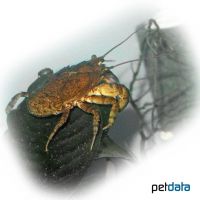Cockroach Crayfish (Aegla platensis)
| Cockroach Crayfish Aegla platensis | |
|---|---|
| Name | Cockroach Crayfish |
| Name Lat. | Aegla platensis |
| Family | Aeglids |
| Family lat. | Aeglidae |
| Order | Decapods |
| Order lat. | Decapoda |
| Origin | South America |
| Habitat | Running waters |
| Diet | Omnivore |
| pH | 6.5-7.5 |
| Behavior | Nocturnal, peaceful |
| Keeping | Group |
| Care Level | Easy |
| Reproduction | Oviparous |
| Breeding | Moderately difficult |
| Life Span | N/A |
| Protection | No |
| Metric Units | |
| Size | 4 cm |
| Temperature | 18-24 °C |
| Hardness | 5-15 °dH |
| Aquarium | ~ 50 l |
| US Units | |
| Size | 1.6" |
| Temperature | 64-75 °F |
| Hardness | 89-267 ppm |
| Aquarium | ~ 15 gal |
Distribution and habitat
Plata crabs are widely distributed in northern Argentina, Uruguay and southern Paraguay, and southern Brazil. They live mainly in flowing waters with sandy-soft bottoms, during the day usually buried in the sand or hidden under wood and stones.
Maintenance
They need a well structured aquarium with roots, stones and plants, in addition caves or crab tubes as hiding places and a graveable substrate of sand or fine gravel as well as a moderate current
Water quality must be that required for average freshwater fish keeping. Regular partial water changes are required to maintain water quality. When using a filter, make sure that no animals can be sucked in
Diet
In the wild they feed on insect larvae, carrion, snails, worms, etc. The food supply consists of live, frozen and dry food. For a balanced diet, feed once a day with a high-quality dry food for crayfish (granules, pellets, tablets), as well as artemia and mosquito larvae (live or frozen)
Unaccepted food must be removed after 4-5 hours. Regular and varied feeding promotes health and prevents deficiency symptoms.
Behaviour and compatibility
They behave peacefully within the species and should be kept together in groups of three to five animals.
They can be socialized with shrimp and other crustaceans as well as small fish, as long as they do not consider the Plata crabs as food. Socialization with snails is not recommended, as these serve as food for them. However, it is recommended to keep them in a species tank.
In principle, only compatible animals with similar requirements to the water condition and water temperature may be socialized.
Reproduction and breeding
The sexes are difficult to distinguish. The males carry the sexual opening on the 5th pair of legs, the females on the 3rd pair of legs
Breeding in the aquarium has been successful several times. After about 10 weeks of gestation about 50 fully developed young are released. The further breeding is difficult, because the parents are cannibalistic.
Important
Due to their peculiarly shortened tail, these crabs look similar to a crab
Temperatures above 24 °C are not tolerated in the long run. Ideal is the keeping of Plata crabs in an unheated aquarium at room temperature.
According to their wide distribution area they come in different color forms. They can also change their color after each moult.
The well-being of the animals should be checked regularly. The temperature should be checked daily, the pH, hardness and nitrate value at least every 14 days. Regular partial water changes are recommended, even if the contaminant level has not yet reached the upper limit. Sudden changes in water quality should be avoided. Newly introduced animals must be accustomed slowly to the water in the aquarium.
Further literature can be found in your pet store.
References
Text: petdata; Image: Franz Lowak
Source: LUKHAUP & PEKNY (2008): Süßwasserkrebse aus aller Welt, Dähne Verlag; ENGELMANN & LANGE (2011): Zootierhaltung - Tiere in menschlicher Obhut: Wirbellose, Verlag Harri Deutsch
